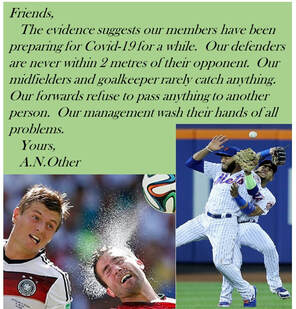
Social distancing is not possible in contact sports. Players in the NFL know there is a rule against "roughing the passer" and not against "touching the passer". The game might be possible to play with no huddle but without contact it would not be football. Other football codes face similar problems. Even when Tag-Rugby gained some popularity as a participant sport, it never commanded TV audiences. Older soccer fans might bemoan the outlawing of a situation where a defender could come through the legs of an attacker to win the ball, but physical contact remains part of the game (and now done at greater speed by better athletes).
Contact sports also require relatively more medical support. The general public might not be impressed by the removal of medical staff from the frontline. The general public might also be less than impressed to find some individuals are being given permission to compete. Will competitors who were previously given therapeutic use exemptions (TUE) for conditions like asthma be allowed compete? Are these not a vulnerable group? Will anti-doping agencies consider their duty of care to such competitors or will they turn a blind-eye?
The more popular team sports tend to be contact sports. Some individual sports also fall foul of the social distancing rule. Various forms of combat sports could not take place, e.g. judo and boxing. While the purpose of some of these sports is to inflict physical damage on your opponent, it is not to give them a disease. It would be possible to have runners compete in lanes. Shorter races, that were traditionally run in lanes, might be able to leave some lanes vacant, e.g. 100m, 200m and 400m. Swimming could do something similar. It should be easy to social distance in golf. Tennis is a borderline example.
Some of these individual sports can be combined into team sports, e.g. the Ryder Cup and the Davis Cup. Some team sports are not that far removed from a similar structure of individual contributions to team outcomes. The batting team in baseball and cricket can easily social distance from their teammates. It is not so easy for their opponents. And man-ball-man contact is permitted/encouraged. The distance between the catcher and batter might prove a problem (maybe different types of personal protective equipment would be needed).
Then there is the issue of common equipment. To what extent is a ball shared and how frequently can it be replaced? Golf should be fine with each player playing their own ball. The ball in tennis could be replaced after each point. In a passage of play during a soccer match, outfield players are not supposed to handle the ball but they do head the ball. How many players could possibly handle the ball during the passage of play in rugby union? There are important differences that could determine when particular sports return to our screens.
What happens when the competitors finish their shift? At this point, the financial rewards of the sport are crucial. Amateur players, and poorly paid professionals, are likely to have to work a second job. What if that second job is in a healthcare setting? Young competitors, who do not earn enough to afford their own accommodation, could be living at home with elderly parents. What sports can afford to cocoon their competitors (and support staff)? The economics of sport will be as important as ever.
 RSS Feed
RSS Feed